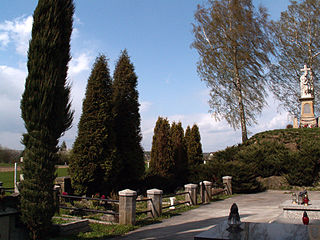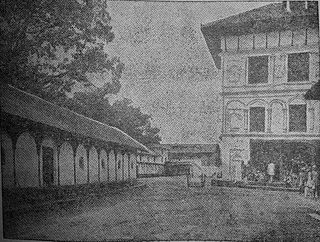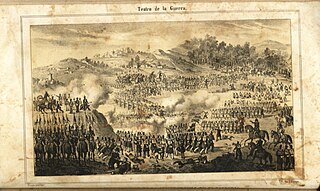 W
WThe Battle of Aliwal was fought on 28 January 1846 between British and Sikh forces in northern India. The British were led by Sir Harry Smith, while the Sikhs were led by Ranjodh Singh Majithia. Britain's victory in the battle is sometimes regarded as the turning point in the First Anglo-Sikh War.
 W
WThe First Anglo-Sikh War was fought between the Sikh Empire and the East India Company in 1845 and 1846 in and around the Ferozepur district of Punjab. It resulted in partial subjugation of the Sikh kingdom and cession of Jammu and Kashmir as a separate princely state under British suzerainty.
 W
WThe Battle of Gdow took place on February 26, 1846 near Gdow, Free City of Krakow. It was the only battle of the Krakow Uprising: a 380-strong rebel unit commanded by Jakub Suchorzewski was defeated by a 480-strong Austrian Army detachment under Ludwig von Benedek. The Austrians were supported by some 500 local peasants. Rebel losses were estimated at 154 killed in action, while Austrian losses were negligible.
 W
WThe Dutch intervention in Northern Bali in 1846 was the first in a long series of Dutch military interventions on Bali island, until total control was achieved with the Dutch intervention in Bali in 1908. The Dutch used as a pretext Balinese salvage claims over shipwrecks, which were customary to the Balinese, but unacceptable to the Dutch.
 W
WThe Emboscada was a palace coup of 6 October 1846, by which queen Maria II deposed the government presided over by Pedro de Sousa Holstein, 1st Duke of Palmela, that had been installed on 20 May that year as a result of the Revolution of Maria da Fonte. By thus dismissing the government of Palmela, that had only come to power 5 months earlier, and replacing it with a Cartista government presided over by João Francisco de Saldanha Oliveira e Daun, 1st Duke of Saldanha, the monarch rekindled the revolt and precipitated the civil war known as the Patuleia.
 W
WThe Flagstaff War, also known as Heke's War, Hōne Heke's Rebellion and the Northern War, was fought between 11 March 1845 and 11 January 1846 in and around the Bay of Islands, New Zealand. The conflict is best remembered for the actions of Hōne Heke who challenged the authority of the British by cutting down the flagstaff on Flagstaff Hill at Kororāreka, now Russell. The flagstaff had been a gift from Hōne Heke to James Busby, the first British Resident. The Northern War involved many major actions, including the Battle of Kororāreka on 11 March 1845, the Battle of Ohaeawai on 23 June 1845 and the siege of Ruapekapeka Pā from 27 December 1845 to 11 January 1846.
 W
WThe Franco-Tahitian War or French–Tahitian War (1844–1847) was a conflict between the Kingdom of the French and the Kingdom of Tahiti and its allies in the South Pacific archipelago of the Society Islands in modern-day French Polynesia.
 W
WThe Galician Slaughter, also known as the Peasant Uprising of 1846 or the Szela uprising, was a two-month uprising of Galician peasants that led to the suppression of the szlachta uprising and the massacre of szlachta in Galicia in the Austrian partition in early 1846. The uprising, which lasted from February to March, primarily affected the lands around the town of Tarnów.
 W
WThe Kot massacre took place on 14 September 1846 when then Kaji Jang Bahadur Kunwar and his brothers killed about 30-40 civil, military officers and palace guards of the Nepalese palace court including the Prime Minister of Nepal and a relative of the King, Chautariya Fateh Jung Shah and other senior-most ministers and army generals at the palace armory (Kot) of Hanuman Dhoka in Kathmandu. The Kot meeting was called upon by Queen Rajya Laxmi Devi after the same night murder of her confidante Kaji Gagan Singh Bhandari while performing worship at his prayer room. The Kot meeting turned ugly and eventually, Jang brothers and their supporters led an open court full-fledged assault on all his rival participants in the meeting. This massacre led to the loss of power of political clans such as Chautariyas, Pandes, Thapas, and Basnyats and that of King Rajendra Bikram Shah and Queen Rajya Laxmi Devi and ultimately the establishment of the Rana autocracy in Nepal.
 W
WThe Kraków Uprising of February 1846 was an attempt, led by Polish insurgents such as Jan Tyssowski and Edward Dembowski, to incite a fight for national independence. The uprising was centered on the city of Kraków, the capital of a small state of Free City of Krakow. It was directed at the powers that partitioned Poland, in particular the nearby Austrian Empire. The uprising lasted about nine days, and ended with Austrian victory.
 W
WThe Mexican–American War, also known in the United States as the Mexican War and in Mexico as the Intervención Estadounidense en México, was an armed conflict between the United States and Mexico from 1846 to 1848. It followed the 1845 U.S. annexation of Texas, which Mexico still considered Mexican territory since the government did not recognize the Velasco treaty signed by Mexican General Antonio López de Santa Anna when he was a prisoner of the Texian Army during the 1836 Texas Revolution. The Republic of Texas was de facto an independent country, but most of its citizens wished to be annexed by the United States. Domestic sectional politics in the U.S. were preventing annexation since Texas would have been a slave state, upsetting the balance of power between northern free states and southern slave states. In the 1844 United States presidential election, Democrat James K. Polk was elected on a platform of expanding U.S. territory in Oregon and Texas. Polk advocated expansion by either peaceful means or by armed force, with the 1845 annexation of Texas furthering that goal by peaceful means. For Mexico, this was a provocation, but Polk went further, sending U.S. Army troops to the area; he also sent a diplomatic mission to Mexico to try to negotiate the sale of territory. U.S. troops' presence was provocative and designed to lure Mexico into starting the conflict, putting the onus on Mexico and allowing Polk to argue to Congress that a declaration of war should be issued. Mexican forces attacked U.S. forces, and the United States Congress declared war.
 W
WThe Patuleia, Guerra da Patuleia, or Little Civil War was a civil war in Portugal, so called to distinguish it from the 'great' civil war between Dom Pedro and Dom Miguel that ended in 1834. The Patuleia occurred after the Revolution of Maria da Fonte, and was closely associated with her. It was caused by the nomination, as a result of the palace coup of 6 October 1846, known as the "Emboscada", to set up a clearly Cartista government presided over by marshal João Oliveira e Daun, Duque de Saldanha.
 W
WThe Revolution of Maria da Fonte, or Revolution of the Minho, is the name given to a popular revolt in the spring of 1846 against the Cartista government of Portugal. The revolt resulted from social tensions remaining from the Liberal Wars, exacerbated by great popular discontent generated by new military recruitment laws, fiscal alterations and the prohibition on burials inside churches. It began in the area of Póvoa de Lanhoso (Minho) by a popular uprising that little by little extended to the whole north of Portugal. The instigator of the initial riots was a woman called Maria, native of the freguesia of Fontarcada, who would become known by the nickname of Maria da Fonte. As the initial phase of the insurrection had a strong female element, she ended up giving her name to the revolt. The uprising afterwards spread to the remainder of the country and provoked the replacement of the government of Costa Cabral by one presided over by Pedro de Sousa Holstein, 1st Duke of Palmela. When queen Maria II dismissed that government in a palace coup, known as the Emboscada (Ambush), on October 6 that year, and instead nominated marshal João Francisco de Saldanha Oliveira e Daun, 1st Duke of Saldanha to form a new one, the insurrection was reignited. The result was a civil war of 8 months, known as the Patuleia, that was only ended by the signing of the Convention of Gramido on 30 June 1847, after the intervention of foreign military forces from the Quadruple Alliance.
 W
WThe Second Carlist War, or the War of the Matiners, was a civil war occurring in Spain. Some historians consider it a direct Catalan revolt against Madrid, fought primarily in Catalonia by the Carlists under General Ramón Cabrera against the forces of the government of Isabella II. The uprising began in September 1846 and continued until May 1849, spreading to Galicia.
 W
WThe Battle of Sobraon was fought on 10 February 1846, between the forces of the East India Company and the Sikh Khalsa Army, the army of the Sikh Empire of the Punjab. The Sikhs were completely defeated, making this the decisive battle of the First Anglo-Sikh War.